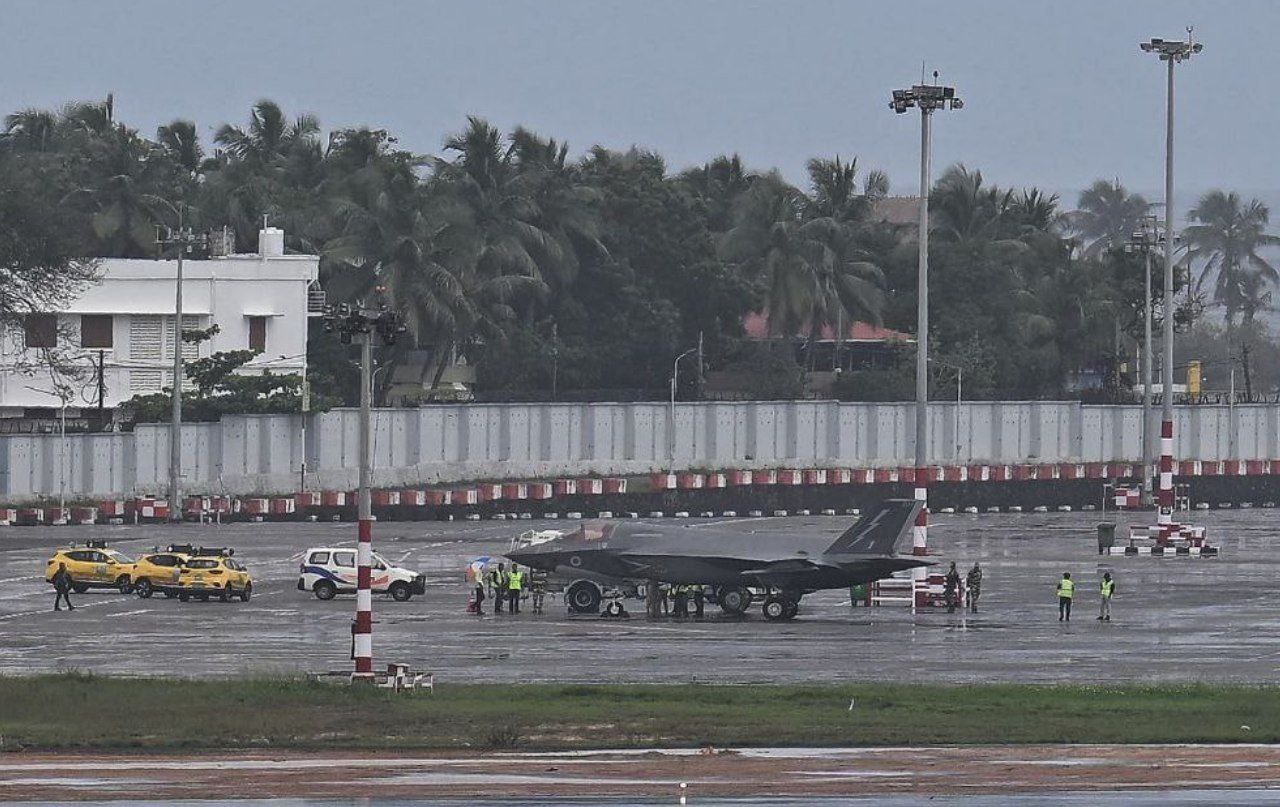The recent emergency landing of the Royal Navy’s F-35 B in India after running dangerously low on fuel has created quite a buzz among aviation buffs in the country.
This is not the first time that the Royal Navy’s deck-based aircraft have been involved in unusual incidents. In 1983, one of the Royal Navy’s Sea Harriers landed on a Spanish cargo ship after losing its mothership and fuel getting perilously low.
The Royal Navy’s F-35 B has been grounded for over 72 hours and is stranded at Thiruvananthapuram airport in South India.
The jet was part of the HMS Prince of Wales Carrier Strike Group that recently concluded a joint maritime exercise with the Indian Navy and was in the Indo-Pacific. The media reports suggest a suspected mechanical failure that has kept one of the most expensive, cutting-edge aircraft unflightworthy.
The F-35B is designed for short take-off and vertical landing, enabling it to operate from aircraft carriers without the need for catapult systems.

In recent times, the Royal Navy’s F-35s have been involved in some bizarre incidents, like one time one of its 5th-generation fighter jets plunged into the ocean immediately after take-off due to an engine cover that was mistakenly left in the intake duct.
But it is the 1983 incident that is worthy of being turned into a movie.
On a fateful day in 1983, a NATO multinational training exercise was at its peak when a Sea Harrier found itself at the centre of an unusual incident. The fighter jet was given the onerous task of locating the French aircraft carrier while adhering to strict security protocols, including radio silence and maintaining a minimal electronic signature.
The fateful aircraft was piloted by 25-year-old Sub-Lieutenant Ian “Soapy” Watson. The young pilot was preparing for his 14th sortie in the Sea Harrier, capable of vertical take-off and landing.
Watson was buddied up with a senior pilot in another Harrier, and they were simulating combat conditions together by maintaining radio silence and keeping the radar off. Upon reaching their search area, they climbed to the designated altitude, turned on their radar, and started looking for the French Carrier.
After completing the search, Watson descended and headed to the predesignated point to rejoin the flight leader. However, Watson could not spot the leader and relied on the inertial navigation system to find his way back to the Illustrious.
But his attempts proved to be futile. Watson later told the Smithsonian magazine: “I went through everything I had in the airplane to help me. I tried the radio. I had the radar on. I squawked emergency. Absolutely nothing. There were no returns on the radar.”
Without navigation aid, Watson relied on the knowledge that the shipping lanes lay off the coast to the east. He headed in that direction, and his radar showed a ship headed towards it.
His fuel was running out fast. At 12 miles, Watson saw the Spanish cargo ship Alraigo. He was planning to eject after making sure the ship saw him.
To grab the attention of the ship’s captain, Watson did a flypast. While moving beside the ship, he saw that the cargo on the ship was aligned to form a deck. It was akin to what Watson had used during training.
Without losing time, Watson leveraged the Harrier’s groundbreaking VTOL (Vertical Take-Off and Landing) capability and executed a vertical landing on the ship—an operation that was as audacious as it was risky. There was minor collateral damage to the vessel’s cargo, which ultimately saved the pilot’s life.
As the Sea Harrier landed on the containers, it started sliding backward. Watson tried to stop it by retracting the landing gear; however, the main gear dropped off the back edge of the container. It damaged a delivery van on the ship that was to be delivered to a florist shop in Tenerife in Spain.

Alraigo did not let the incident disrupt his schedule and reached his destination in Tenerife in four days.
The cargo ship was received amidst considerable media attention, especially for its additional load. The ship’s crew and owners filed a salvage claim and were awarded £570,000 ($1.14 million at the time) as compensation for the “rescue.”
A board of Inquiry onboard Illustrious did not find anything blameworthy in Watson’s course of action. However, a second Board of Inquiry was constituted by the Royal Navy.
It stated that Watson had completed only 75 percent of his training before being sent on the mission and blamed his inexperience on the mission going awry.
The Board blamed his commanders for assigning him an airplane “not fully prepared for the sortie,” a reference to radio problems. That notwithstanding, Watson was reprimanded and assigned a desk job.
Watson went on to acquire 2,000 hours on Sea Harriers and 900 in F/A-18s before he retired in 1996. The aircraft ZA176 was later converted to the FA2 variant and retired, eventually going on display at the Newark Air Museum.




